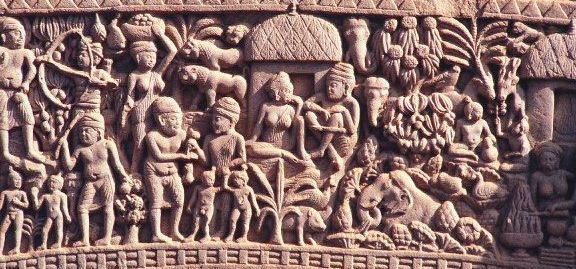HOUSEHOLD LIFE, THE

The household life (gharàvàsa) refers to living in a home with a spouse and children and working to support them and oneself. Throughout the Tipiñaka, a sharp contrast is drawn between the life of the householder and that of monks and nuns. The first is described as `dusty and confining' (rajàpatha) while the second is said to be as `free as the breeze' (abbhokàsa, D.I,63). However, this may be too simple a generalization. At the time of the Buddha, monks and nuns had a great deal of freedom but their lives were also hard and insecure. Most had no permanent places of residence and had to endure `cold and heat, hunger and thirst, the bites of gnats and mosquitoes, the wind, the sun and creepy crawlies'(M.I,10). And many incidents recorded in the Vinaya show that even monasteries were not free from personal tensions, jealousies and disagreements, sometimes quite serious ones (M.I,321).
By contrast, a householder might have `a gable-roofed house, well-plastered inside and out, with secure doors and windows, furnished with a couch spread with a woollen rug, a white cover, embroidered blankets, a costly deer skin, a canopy above and crimson pillows at each end, a lamp burning next to it and two wives to attend to him with all their charms' (A.I,137). Despite such domestic cosiness, the average person's life also had its drawbacks. The ancient Indian social structure meant that within the house a man was always subject to his parents and in society to the stifling demands of the caste system. The situation was worse for women. They were completely subservient to their mother-in-law and husband and because birth control was either nonexistent or unreliable, they had to endure numerous pregnancies. The extended family gave great emotional comfort and support but it could also create numerous interpersonal conflicts and make individuality and privacy difficult. Notwithstanding these and other difficulties, the Buddha advised his lay disciples to practise meditation `as you go about your business, as you dwell in your home crowded with children'(A.V,333), and some lay people attained enlightenment, while thousands of others attained the stages leading up to enlightenment (M.I,491-92).
So the household life in the 5th century BCE probably was far less conducive to the spiritual quest than the monastic life. But society and family life have changed beyond comparison since then. Today, at least in the West, household life (whether married or single) probably offers more freedom, privacy, spare time and opportunities to study and practise than ever before in history. This being the case, the idea that the Dhamma cannot be fully practised by householders is no longer valid.
And if household life has changed since the Buddha's time, then monastic life has changed even more. Today, much of the average monk's time revolves around pastoral duties; blessing ceremonies, preparing and delivering sermons, conducting funerals, informal counselling, studying for the monastic exams, participating in various festivals, etc. The average abbot spends much of his time trying to find the money to maintain and repair the monastery and pay next month's power bills.
For some people the biggest hurdle to spiritual growth is not that they are unable to become a monk or nun but their conviction that they cannot grow spiritually unless they become a monk or a nun; an attitude which prevents them from even trying to practise the Dhamma more fully. In reality, the household life is as rich in spiritual opportunities as the monastic life is. `But what about sex?' `What about the difficulties in bringing up children?' some will ask. Sexual desire is a hindrance to the spiritual life but this desire does not necessarily vanish when one puts on a yellow robe. Despite being celibate and committed to meditation, some monastics struggle with sexual desire all their lives. Likewise, sex is important for most householders during the early part of their marriage but for some becomes less so as time goes by. And, of course, some unmarried people and even some who are married, are celibate without making a vow to be.
It is true that bringing up children is challenging and time consuming. But it is equally true that living with children, like living with a partner, offers opportunities to develop some of the most important spiritual qualities. Being a parent and a partner often requires that one put aside or postpone one's wishes for the sake of others and this can help to perfect acceptance and renunciation. It requires patience, generosity, forgiveness and self-sacrifice. Children and partners can also nourish one with love, companionship, tenderness and emotional support, qualities so essential for psychological well-being and sometimes absent in monasteries.
Ultimately, if a distinction is to be made between people it should not be based on the colour of the clothes but the quality of the mind. The Buddha said: `Even though being finely adorned, if one is peaceful, restrained, committed to the holy life and harmless towards all beings, he is a true ascetic, a true priest, a true monk'(Dhp.142). Rohitassa once told the Buddha that he had tried to find `the end of the world', i.e. nirvana, by going, but never succeeded. The Buddha told him the reason for this was because `the end of the world' is not to be found by going anywhere but by looking within (S.I,62). You can look within whether you live in a house or a monastery or whether you wear blue jeans or a yellow robe. See Upàsaka and Upàsikà.